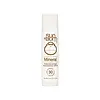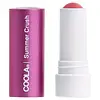What's inside
What's inside
 Key Ingredients
Key Ingredients

 Benefits
Benefits

 Concerns
Concerns

 Ingredients Side-by-side
Ingredients Side-by-side

Zinc Oxide 8%
Cosmetic ColorantPrunus Amygdalus Dulcis Oil
Skin ConditioningSimmondsia Chinensis Seed Oil
EmollientButyrospermum Parkii Butter
Skin ConditioningCera Alba
EmollientEuphorbia Cerifera Wax
Argania Spinosa Kernel Oil
EmollientCaprylic/Capric Triglyceride
MaskingTocopheryl Acetate
AntioxidantCopernicia Cerifera Wax
Tocopherol
AntioxidantGlycine Soja Oil
EmollientGlyceryl Caprylate
EmollientBisabolol
MaskingPolyhydroxystearic Acid
EmulsifyingPolyglyceryl-3 Oleate
EmulsifyingIsostearic Acid
CleansingLecithin
EmollientGlyceryl Undecylenate
EmollientZinc Oxide 8%, Prunus Amygdalus Dulcis Oil, Simmondsia Chinensis Seed Oil, Butyrospermum Parkii Butter, Cera Alba, Euphorbia Cerifera Wax, Argania Spinosa Kernel Oil, Caprylic/Capric Triglyceride, Tocopheryl Acetate, Copernicia Cerifera Wax, Tocopherol, Glycine Soja Oil, Glyceryl Caprylate, Bisabolol, Polyhydroxystearic Acid, Polyglyceryl-3 Oleate, Isostearic Acid, Lecithin, Glyceryl Undecylenate
Titanium Dioxide
Cosmetic ColorantZinc Oxide
Cosmetic ColorantCocos Nucifera Oil
MaskingOlea Europaea Fruit Oil
MaskingCopernicia Cerifera Wax
Persea Gratissima Oil
Skin ConditioningJojoba Esters
EmollientOctyldodecyl Oleate
EmollientButyrospermum Parkii Butter
Skin ConditioningSchinziophyton Rautanenii Kernel Oil
EmollientAroma
Theobroma Cacao Seed Butter
EmollientHydrogenated Castor Oil
EmollientTheobroma Grandiflorum Seed Butter
Skin ConditioningOctyldodecyl PCA
EmollientHelianthus Annuus Seed Wax
Skin ConditioningAcacia Decurrens Flower Wax
EmollientPolyglycerin-3
HumectantRosmarinus Officinalis Leaf Extract
AntimicrobialHelianthus Annuus Seed Oil
EmollientPolyhydroxystearic Acid
EmulsifyingC18-38 Alkyl Hydroxystearoyl Stearate
EmollientStevia Rebaudiana Extract
Caesalpinia Sappan Bark Extract
Skin ConditioningSilica
AbrasiveIron Oxides
Mica
Cosmetic ColorantTin Oxide
AbrasiveTitanium Dioxide, Zinc Oxide, Cocos Nucifera Oil, Olea Europaea Fruit Oil, Copernicia Cerifera Wax, Persea Gratissima Oil, Jojoba Esters, Octyldodecyl Oleate, Butyrospermum Parkii Butter, Schinziophyton Rautanenii Kernel Oil, Aroma, Theobroma Cacao Seed Butter, Hydrogenated Castor Oil, Theobroma Grandiflorum Seed Butter, Octyldodecyl PCA, Helianthus Annuus Seed Wax, Acacia Decurrens Flower Wax, Polyglycerin-3, Rosmarinus Officinalis Leaf Extract, Helianthus Annuus Seed Oil, Polyhydroxystearic Acid, C18-38 Alkyl Hydroxystearoyl Stearate, Stevia Rebaudiana Extract, Caesalpinia Sappan Bark Extract, Silica, Iron Oxides, Mica, Tin Oxide
 Reviews
Reviews

Ingredients Explained
These ingredients are found in both products.
Ingredients higher up in an ingredient list are typically present in a larger amount.
This ingredient is also known as shea butter. It is an effective skin hydrator and emollient.
Emollients help soothe and soften your skin. It does this by creating a protective film on your skin. This barrier helps trap moisture and keeps your skin hydrated. Emollients may be effective at treating dry or itchy skin.
Shea butter is rich in antioxidants. Antioxidants help fight free-radicals, or molecules that may harm the body. It is also full of fatty acids including stearic acid and linoleic acid. These acids help replenish the skin and keep skin moisturized.
While Shea Butter has an SPF rating of about 3-4, it is not a sunscreen replacement.
Shea butter may not be fungal acne safe. We recommend speaking with a professional if you have any concerns.
Learn more about Butyrospermum Parkii ButterCopernicia Cerifera Wax comes from a palm tree native to Brazil; another name for this ingredient is Carnauba Wax.
This ingredient is used to thicken texture and also leaves behind a film when applied.
Fun fact: This wax has the highest melting point of all natural waxes and low solubility.
Learn more about Copernicia Cerifera WaxPolyhydroxystearic Acid is a soft wax made from castor oil.
It is is a texture thickener, emulsifier, and film-former. Emulsifiers prevent ingredients from separating, such as oils and waters.
Polyhydroxystearic Acid may not be fungal acne safe.
Learn more about Polyhydroxystearic AcidZinc Oxide is a mineral broad-spectrum UV filter; it is the broadest UVA and UVB reflector approved by the FDA. It also has skin protectant and skin soothing properties.
Zinc oxide is one of the most effective broad-spectrum UV filters. It protects against UVB, UVAII, and UVAI. In comparison to its counterpart titanium dioxide, zinc oxide provides uniform and extended UVA protection.
Another great benefit? This ingredient is highly photostable so it won't degrade easily under sunlight.
A common myth is that mineral UV filters are widely believed to primarily reflect UV light.
However, modern research shows titanium dioxide absorbs UV radiation like chemical filters (~95% absorption & 5% reflection).
Zinc oxide has great skin soothing properties so you'll likely find this in sunscreens formulated for sensitive skin or babies/children. It is unlikely to cause "eye sting" like other sunscreen ingredients.
Regulatory agencies consider zinc oxide to be non-toxic and safe. It has also been shown to not penetrate the skin.
Unfortunately, this ingredient does leave a visible white cast. This is why mineral sunscreens are often less cosmetically elegant than chemical or hybrid ones.
In cosmetics, zinc oxide can be found in both non-nano and nano-sized forms. The nano version is used to reduce white cast and improve the texture of sunscreen formulas.
There are ongoing concerns surrounding nano-zinc oxide's impact on marine ecosystems and whether it can be absorbed into skin.
Regarding marine ecosystems and coral reefs, there is no conclusive evidence that any form of zinc oxide (or any other sunscreen ingredients) will cause harm. The science is still developing but many consumers are keeping a close eye on this issue.
Please note, many destinations have reef-safety sunscreen rules. For instance, the U.S. Virgin Islands advises all visitors to use non-nano mineral sunscreens.
There has also been some stir about whether micronized or nano zinc oxide has potential photoxicity and absorption through the skin/lungs.
An in-vitro (done in a test tube or petri dish) study demonstrated micronized zinc oxide to have potential phototoxicity. There's no need to fret; the EU Commission's Scientific Committee on Consumer Safety has stated, "The relevance of these findings needs to be clarified by appropriate investigations in vivo." Or in other words, further studies done on living organisms are needed to prove this.
Current research shows zinc oxide nanoparticles do not penetrate intact or sunburned skin. They either remain on the surface or in the outermost layer of dead skin (stratum corneum).
Zinc oxide is one of only two classified mineral UV filters with titanium dioxide being the other one.
Fun fact: Zinc has been used throughout history as an ingredient in paint and medicine. An Indian text from 500BC is believed to list zinc oxide as a salve for open wound. The Ancient Greek physician Dioscorides has also mentioned the use of zinc as an ointment in 1AD.
Learn more about Zinc Oxide